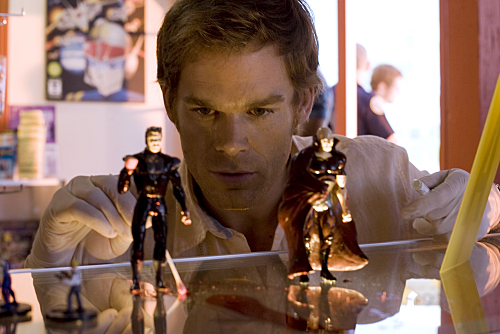
This week, our guy psychopez put up a post about Han Solo Theory and Campaign Design. I’m not going to get too far into it, but he outlines the idea of having an everyman that players can relate to being important to buy-in. Great write-up.
I’m going to introduce a new theory that players and DMs can use to make character design less of a hassle to work through. I’m calling it: The Dexter Theory.
This theory is inspired by the television program ‘Dexter’ seen on Showtime. My wife and I are huge fans of the show, and have often talked about the things that make the show a good watch. One of the most important aspects we have touched on is the characters. The writers of the show have crafted the characters in such a way that the viewer is compelled to feel very specific things about them. We identify with Dexter. We love Rita. We hate Lila. We wanted Doakes to die… until we got to know him. How did this happen?
They Play to Stereotypes
Preface: This is NOT ok in real life. So, if you’re reading this, Al Sharpton, this doesn’t make me a racist. These aren’t the droids you’re looking for. Move along.
Alright, now that I’ve gotten it out of the way, the writers of this show had only one thing to sell the show. It’s about a serial killer who kills bad guys. Fair enough, but what about a cast? Let’s run it down:
- Dexter: White male. Early 30s. Genius-level intellect. Serial killer.
- Deborah Morgan: Female vice cop. Gruff. Wants a better job, but can’t get past a glass cieling. Damsel in distress.
- Rita Bennet: Girlfriend to Dexter. Victim of abuse. 2 kids.
- Vince Masuka: Asian. Lab technician. Kind of a sex fiend.
- James Doakes: Tough black cop with a chip on his shoulder. Trusts no one.
- Angel Batista: Cuban hispanic male. Loves dancing. Family man.
Catch something there? Every one of those characters is a cookie cutter image of stereotypes present in our cultural consciousness. (Again, I’m not saying that this is right, or that I even agree with it, so relax.)
Now, what’s the first thing they do once they establish these stereotypical archetypes?
They Shatter the Conventions
As the show progresses, characters have come out of the process as fully realized personages. The tough black cop turns out to be a former black ops operative who was abused as a child. The Cuban turns out to be the Sir Galahad of the bunch, unable to lie, becoming the moral compass to for the show. Dexter himself becomes something of a complex blend of traits, balancing the desire to kill with the need to do right. I could write pages about each of these characters, and that’s the way it’s supposed to be. We like these characters because the grow into something more than a one sentence description.
So, What Does This Mean For Me?
Funny you should ask. When building your character, it can be very effective to start with an archtype and let the story happen. Start with a blank page. Write your character’s name, race, and class (or whatever your particular system uses to deliniate characters). Write down a pertinent fact about an ability score (low CHA because of nasty scars on face, curmudgeony demeanor, whatever). That’s it.
Don’t talk extensively about background. If your greatest life experiences happened before you started adventuring, then why do we care about what you’re doing now? The term adventurer implies one very important thing: Adventuring. So, do that.
Every time something happens to your character, think about how it affects him or her. Write that down on the sheet you’re keeping. Everything that your character experiences then adds up. You may need a new sheet. That’s ok. Highlight things you think are important to your character’s attitudes. Before long, your Halfling Rogue with a low WIS that used to get caught picking pockets is a fully realized fictional person, with drives and motivations that set him apart from other Halfling who took up the Rogue’s life.
Here’s a fine example: your standard elf ranger and your standard dwarf fighter. Both are fairly typical stat-wise, and neither deviates from the standard guidelines. As such, they each believe themselves superior to the other, so they start keeping track of who can kill more orcs. By the time they’ve finished, their rivalry has moved beyond its initial antagonism, and became a lifelong friendship. If you didn’t already know, the names on the character sheets are Legolas and Gimli. It helps that they are the standard from which the stereotypes are drawn, but the principle holds. We learn about them as they do things, not from what was written about them before.
So, is this a viable concept for character building? Does this help? Am I talking nonsense? Let me know. Oh, and watch your threatened squares…
Dexter is the property of Showtime Networks, Inc.
Update 12/3: GeekKen posted a great piece on prejudice as an RP tool. Read it here
